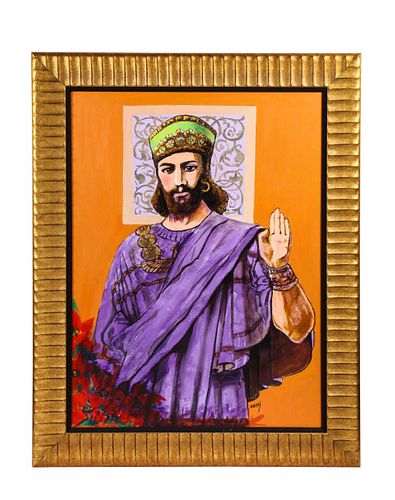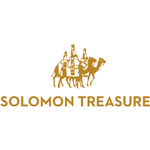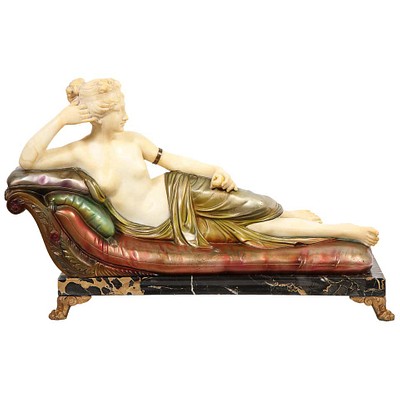Nasser Ovissi 'Iranian, Born 1934' "King Cyrus The Great" Oil on Canvas Painting
Lot 20
About Seller
Solomon Treasure
1050 2nd Ave #83
NY, NY 10022
United States
Four Generations of collecting exquisite European Art & Antiques.
About Auction
By Solomon Treasure
Oct 29, 2020 - Nov 29, 2020
Set Reminder
2020-10-29 00:00:00
2020-11-29 00:00:00
America/New_York
Bidsquare
Bidsquare : Thanksgiving Sale!
https://www.bidsquare.com/auctions/solomon-treasure/thanksgiving-sale-5936
Fall Collector Opulent Auction - No Buyers Premium! Solomon Treasure mory@solomontreasureny.com
Fall Collector Opulent Auction - No Buyers Premium! Solomon Treasure mory@solomontreasureny.com
- Lot Description
Nasser Ovissi, 'Iranian, Born 1934' "Cyrus The Great" Oil on Canvas Painting. Very fine quality painting by Persian Artist Nasser Ovissi who is considered to be known as the "Picasso of Iran". A true modern Iranian masterpiece depicting "King Cyrus The Great" dressed in purple linen garments, with a green turban, in a vibrant orange background. Oil on canvas, framed. Signed. Canvas Size: 29" high x 39" wide Frame Size: 49" high x 39" wide Cyrus II of Persia commonly known as Cyrus the Great and also called Cyrus the Elder by the Greeks, was the founder of the Achaemenid Empire, the first Persian Empire. Under his rule, the empire embraced all the previous civilized states of the ancient Near East, expanded vastly and eventually conquered most of Western Asia and much of Central Asia. From the Mediterranean Sea and Hellespont in the west to the Indus River in the east, Cyrus the Great created the largest empire the world had yet seen. Under his successors, the empire eventually stretched at its maximum extent from parts of the Balkans and Eastern Europe proper in the west, to the Indus Valley in the east. His regal titles in full were The Great King, King of Persia, King of Anshan, King of Media, King of Babylon, King of Sumer and Akkad, and King of the Four Corners of the World. The Nabonidus Chronicle notes the change in his title from simply "King of Anshan," a city, to "King of Persia." Assyriologist FranМ¤ois Vallat wrote that "When Astyages marched against Cyrus, Cyrus is called 'King of Anshan," but when Cyrus crosses the Tigris on his way to Lydia, he is 'King of Persia.' The coup therefore took place between these two events. The reign of Cyrus the Great lasted c. 30 years. Cyrus built his empire by first conquering the Median Empire, then the Lydian Empire, and eventually the Neo-Babylonian Empire. He led an expedition into Central Asia, which resulted in major campaigns that were described as having brought "into subjection every nation without exception." Cyrus did not venture into Egypt, and was alleged to have died in battle, fighting the Massagetae along the Syr Darya in December 530 BC.[He was succeeded by his son, Cambyses II, who managed to conquer Egypt, Nubia, and Cyrenaica during his short rule. Cyrus the Great respected the customs and religions of the lands he conquered. This became a very successful model for centralized administration and establishing a government working to the advantage and profit of its subjects. In fact, the administration of the empire through satraps and the vital principle of forming a government at Pasargadae were the works of Cyrus. What is sometimes referred to as the Edict of Restoration (actually two edicts) described in the Bible as being made by Cyrus the Great left a lasting legacy on the Jewish religion. According to Isaiah 45:1 of the Hebrew Bible, God anointed Cyrus for this task, even referring to him as a messiah (lit. 'anointed one') and he is the only non-Jewish figure in the Bible to be called so. Cyrus the Great is also well recognized for his achievements in human rights, politics, and military strategy, as well as his influence on both Eastern and Western civilizations. Having originated from Persis, roughly corresponding to the modern Iranian province of Fars, Cyrus has played a crucial role in defining the national identity of modern Iran.The Achaemenid influence in the ancient world eventually would extend as far as Athens, where upper-class Athenians adopted aspects of the culture of the ruling class of Achaemenid Persia as their own. Cyrus is a cult figure amongst modern Iranians, with his tomb serving as a spot of reverence for millions of people. In the 1970s, the last Shah of Iran Mohammad Reza Pahlavi identified his famous proclamation inscribed onto the Cyrus Cylinder as the oldest known declaration of human rights,and the Cylinder has since been popularized as such. This view has been criticized by some historians as a misunderstanding of the Cylinder's generic nature as a traditional statement that new monarchs make at the beginning of their reign. Artist information: Nasser Ovissi is an American-Iranian painter whose work is characterized by stylized figures of Arabic women and horses. Set amidst geometric patterns and decorative elements, his figures seem to merge into and out of the space behind them. ‰ЫПMy work is dedicated to the beauty of life and I hope those who experience my work will walk away with an experience of beauty.‰Ыќ Born in Tehran, Iran in 1934, Ovissi studied Law and Political Sciences at the University of Tehran before studying Fine art at Beaux Fine Art in Rome. The artist has achieved numerous awards and honors, including being exhibited at the 1959 Paris Biennial and a grand prize at the 1962 Biennale of fine arts of Tehran. Ovissi lives and works in Reston, VA. His works are included in the collections of the Contemporary Art Museum in Madrid and the National Art Gallery of Greece in Athens. Artist Exhibitions: 1957 Tehran, First Prize 1959 Paris Biennial 1960 Tehran, Exhibition in Farhang Hall, during the International Congress of Music 1961 Exhibition in Bombay, India New Delhi, International Exhibition of Contemporary Art Tehran, Iran, First Prise in Drawing Competition 1962 Tehran Biennial (Abyaz Palace), Grand Prize of the Biennial Venice, Italy Biennial 1963 Paris, Museum of Modern Art; Exhibition of Iranian Painters Sao Paulo Biennial, Brazil 1964 Tehran Biennial, Grand Prize 1965 Rome, National Museum of Oriental Art 1966 Milan, San Fedele Gallery 1968 Rome: Gallery 88 Florence, International Biennial of Graphic Arts New York, Columbia University, Modern Iranian Art Italy, Gold Medal at the Campione International Salon 1969 Zurich, Huber Gallery 1970 Ankara, Fine Arts Gallery 1971 Rome, Temple University Athens, Fine Arts Salon New York, Columbia University Washington, Agra Gallery 1972 Paris, Autumn Salon, Grand Palais Paris, Guiot Gallery Ottawa, National Art Center Ottawa, University of Ottawa Baltimore, John Hopkins Gallery Brussels, Palace of Fine Arts 1973 Belgrade, Museum of Modern Art Monaco, International Art Exhibition (Grand Prize) 1976 Basel, Feriart 1977 Madrid, Bruaugut Gallery 1978 Valence, Artis Gallery 1978 Madrid, Contemporary Art Museum 1979 Caracas, Guipuzcoa Gallery 1981 Washington, D.C., Calvert Collection 1982 Dallas, International Art Exhibition 1983 Houston, Texas, Galeria Arte 1984 Pasadena, Pacific Asia Museum Washington, D.C., Calvert Collection Washington, D.C., World Bank New York, Leila Taghinia-Milani Gallery 1985 Paris (France), Mille et Une Nuits New York: Taghinia-Milani Gallery Washington, D.C., Calvert Collection 1986 New York, Mussavi Art Center Washington D.C., Fine Arts Gallery, Georgetown Park Vancouver (Canada), The Art Circle Visalia (California), The Art Circle 1987 New York, Art Expo Cadiz (Spain), Sato Grande Fairfax (Virginia), Broadway Gallery 1988 Los Angeles, Galeria Arte Washington, D.C., Fine Arts Gallery, Georgetown Park McLean (Virginia), Abott Gallery Geneva (Switzerland), Bronz Gallery 1989 New York, Mussavi Art Center San Francisco, Hourian Art Gallery 1990 Montreal (Canada), Maison d'Art Saint Laurent Maui (Hawaii), Metropolitan Art Gallery 1991 Montreal (Canada), Maison d'Art Saint Laurent Austin (Texas), University of Texas Art Gallery New York, Elaine Benson Gallery Maui (Hawaii), Metropolitan Gallery Boca Raton (Florida), Curzon Gallery 1992 Maui (Hawaii), Metropolitan Gallery New York, Space Gallery McLean (Virginia), Tower Club Los Angeles, Beverly Hills Town Center 1993 Cambridge (Massachusetts), Harvard University Maui (Hawaii), Metropolitan Gallery Boca Raton (Florida), Curzon Gallery Washington, DC, Very Special Art Gallery 1994 Tokyo (Japan), Metropolitan Gallery Maui (Hawaii), Metropolitan Gallery Osaka (Japan), Metropolitan Gallery Detriot (Michigan), Michigan University Montreux (Canada), Aurom Gallery Boca Raton (Florida), Curzon Gallery 1995 Washington, DC, Designer Art Gallery 1996 Great Exhibition at Art Festival, Kuwait 1997 Montreal (Canada), Maison d'Art Saint Laurent Tokyo (Japan), Metropolitan Gallery Maui (Hawaii), Metropolitan Gallery Osaka (Japan), Metropolitan Gallery 1998 Fez (Morocco), Sufi Music Festival Los Angeles (California), Exhibition Art Centre Hawaii, Dole Gallery 1999 London (U.K.), Bourlet Gallery Montreux (Switzerland), The Oriental Palace Cyprus, Hilton Hotel Nicosia 2000 Sacramento (California), Sacramento State Library San Bernardo (California), San Bernardo Art Museum Bilbao (Spain), Galeria Uranga 2001 Amman (Jordan), National Gallery of Art Napel (Florida), Visiting Artist Gallery Nice (France), Original Art Gallery 2002 New York, Nour Foundation Washington DC, Embassy of Spain Los Angeles (California)- Persian Cultural Center Sacramento (California)- Public Library Los Angeles (California)- Mimi Gallery 2003 Abu Dhabi, Abu Dhabi Cultural Center (UAE) Dubai, Private Gallery, (UAE), Arta Foundati 2004 Nour Foundation, New York: 2005 Arta Gallery, Toronto Hourian Gallery, San Francisco 2006 Iranian Doctors Association, San Diego Iranian Cultural Association, Chicago Iranian Cultural Association, New Jersey 2007 Nour Foundation, New York Awards: 1957- First Prize in Painting Exhibition in Tehran, Iran 1961- First Prize in Drawing Competition in Tehran, Iran 1962- Grand Prize in the Biennale of Fine Arts of Tehran, Iran 1964- Fourth Prize, Biennale of Tehran 1968- Gold Medal, International Exhibitionof Campione, Italy 1974- Grand Prize, Monaco Contemporary Art Exhibition, France Collections: In Italy, France, England, Greece, Switzerland, Germany, Turkey, India, Sweden, Canada, Spain, United States of America and Iran New York Univeristy Art Collection, Abby Grey Collection, New York National Art Gallery of Athens, Greece Collection of Farah Pahlavi Fine Arts Museum of North Carolina Art Museum of Campione, Italy Contemporary Art Museum, Madrid, Spain Contemporary Art Museum, Tehran Contemporary Art Museum, Kerman, Iran National Library Art Collection, Madrid, Spain Contemporary Art Museum, Tehran, Iran Contemporary Art Museum, Rome, Italy.Excellent
Condition
- Shipping Info
-
In House
-
- Payment & Auction Policies
-
Available payment options
-



 EUR
EUR CAD
CAD AUD
AUD GBP
GBP MXN
MXN HKD
HKD CNY
CNY MYR
MYR SEK
SEK SGD
SGD CHF
CHF THB
THB






















